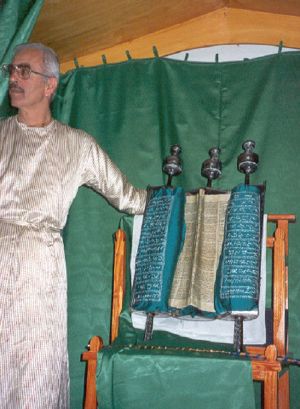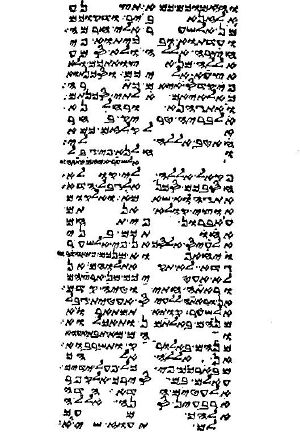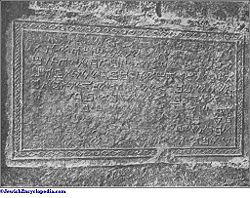Samaritan Pentateuch
The Samaritan Pentateuch is the text of the Pentateuch (the first five books of the Bible, also called the Torah or Law) that is used by the Samaritans. It is written in the Samaritan alphabet, which is believed by scholars to be an older form of Hebrew.
Scholars use the Samaritan Pentateuch to compare against other versions of the Pentateuch to determine the text of the original Pentateuch and to trace the development of text-families. Scrolls among the Dead Sea scrolls have been identified as proto-Samaritan Pentateuch text-type.[1]
The Samaritan practices are based on the five books of Moses, namely the Torah. They have a slightly different version of the Torah (Samaritan Pentateuch) than that accepted by the Jews and Christians. There are minor differences such as the ages of different people mentioned in bibliography, and major differences such as a commandment to be monogomous in the Samaritan Torah as opposed to their Jewish counterpart (Lev. 18:18).
Background
Samaritans descend from the northern Israelite kingdom of Israel. According to the Hebrew Bible, the political division between the southern kingdom of Judea and northern kingdom of Israel, took place after the reign of Solomon with the northern leader Jeroboam becoming the king of Israel and Rehoboam, the son of Solomon ruling Judah. The Samaritans, however, maintain that in fact the northern kingdom, the capital of which was Samaria, never joined the kingdom of David and Solomon. They contend that the Mount Gerizim, located near the ancient town of Shechem, is the location ordained by God as the authorized site of the Temple of Yahweh as described in the Torah. The Temple of Jerusalem was therefore never the true temple. Moreover, they rejected the Jewish priesthood as illegitimate, having descended from the priest Eli of Shiloh, who, according to Samaritan tradition, was originally a priest at Gerizim who established an unauthorized priestly tradition that was later moved to Jerusalem. They also reject both the northern and the southern kings, believing that God did not approve of either royal tradition.
In Jewish tradition, the northern kingdom was conquered by the Assyrians, and the southern kingdom by the Babylonians. Today's Samaritans are the remnants of those who were not exiled from the land during the Assyrian period, and who continuously practiced the ancient religion of Moses and passed it down even in the most difficult oppressed times. However, when the Jews returned from Babylonian exile, they rejected the Samaritans because they had intermarried with non-Israelites. The nation of Samaria thereafter became Judea's rival with its own Temple of Yahweh on Mount Gerizim. There were several wars between the Jews and Samaritans in history, on the basis of both religion and politics.
Samaritans accept on the Torah—the first five book of the Hebrew Bible, also called the Pentateuch—as authoritative, rejected the writings of the prophets and the wisdom literature which are part of the Jewish and Christian scriptures. They also reject the oral law of the Jews, namely the rabbinical traditions which came to be written in the Talmud. They use their own oral law, which has been practiced over the generations; and which they believe is the original practice that Moses taught the children of Israel at Mount Sinai assembly.
The most celebrated of the copies of the Samaritan Pentateuch is Abisha Scroll, which is used in the Samaritan synagogue of Nablus. This scroll was allegedly penned by the high priest Abisha, great-grandson of Aaron, thirteen years after the Israelites entry into the land of Israel under the leadership of Joshua, son of Nun. Abisha claims for himself the authorship of the manuscript in a speech in the first person at Deuteronomy 5:6 in the standard text. Modern scholars doubt that this could actually be the case, but the scroll is definitely of great antiquity.
Differences with the Hebrew text
The Samaritan Pentateuch is written in the Samaritan alphabet, which differs from the biblical Hebrew alphabet. It is considered by some to be the form in general use before the Babylonian captivity. There are also other peculiarities in the writing.
Comparisons between the Hebrew Masoretic text, the Greek Septuagint text and the Samaritan version if the Pentateuch indicate that the Samaritan version is more closely related to Septuagint. In about two thousand out of the 2,000 instances in which the Samaritan and Masoretic texts differ, the Septuagint (LXX) agrees with the Samaritan. For example, Exodus 12:40 in the Samaritan and the LXX reads:
- "Now the sojourning of the children of Israel and of their fathers which they had dwelt in the land of Canaan and in Egypt was four hundred and thirty years."
In the Masoretic text, the passage reads:
- "Now the sojourning of the children of Israel, who dwelt in Egypt, was four hundred and thirty years."
The Samaritan version of the Ten Commandments commands the Israelites specifically to build a sacred altar on Mount Gerizim, which would be the site at which all sacrifices should be offered.[2] The Hebrew Bible does mention Mount Gerizim as a sacred place, but in a different context: "When the Lord your God has brought you into the land you are entering to possess, you are to proclaim on Mount Gerizim the blessings, and on Mount Ebal the curses." (Deuteronomy 11:29)
Scholarship
In the early Christian centuries the Samaritan Pentateuch was frequently mentioned in the writings of the Church Fathers and in marginal notes to old manuscripts, but in the course of time it was forgotten, for more than a millennium.
Wider interest in the Samaritan Pentateuch commenced in 1616, when the well-known traveler Pietro della Valle purchased a copy at Damascus a copy of the text. This copy, now thought to date from about a century earlier, came into the possession of the library of the Oratory at Paris and was printed in 1645 in the Paris Polyglot in an edited version by Jean Morin, a Jesuit convert from Calvinism to Catholicism who believed that the Septuagint and the Samaritan texts were superior to the Hebrew Masoretic text. It was republished again in Walton's Polyglot in 1657. Since then many copies, some of them much older that della Valle's, have come to Europe and America.
The views of scholars as to the antiquity of the Samaritan Pentateuch vary. Some maintain that the Samaritans inherited the Pentateuch from their Israelite forebears who were left in the country at the time of the Assyrian conquest of Israel in the eighth century B.C.E. In 2 Kings 17 evidence exists for the continued presence of Israelite priests in the area: "Then the king of Assyria gave this order: 'Have one of the priests you took captive from Samaria go back to live there and teach the people what the god of the land requires.' So one of the priests who had been exiled from Samaria came to live in Bethel and taught them how to worship the Lord." (2 Kings 17:27-28)
Others, however, hold the view that the Samaritans did not come into possession of the Pentateuch until they were definitely formed into an independent community of the Babyonian exile. This much, however, is certain. It is nearly certain that the Samaritans were already using some for of the Torah at the time of the establishment of their temple on Mount Gerizim, in the time of Nehemiah, but whether this was the Samaritan version or the Jewish version is uncertain.
Scholarly evaluation of the Samaritan Pentateuch has changed after the discovery of the Dead Sea Scrolls, some manuscripts of which display a text that corresponds closely to that of the Samaritan Pentateuch. This shows that, apart from the clearly Samaritan references to the worship of God on Mount Gerizim, the distinction between the Samaritan and Jewish versions was not as clear-cut as previously thought.
The first English translation directly from the oldest Samaritan text was expected to be published by late 2008 by Benyamim Tsedaka, an active member of the Samaritan community.
See also
Notes
- ↑ The Canon Debate, McDonald & Sanders editors, 2002, chapter 6: Questions of Canon through the Dead Sea Scrolls by James C. VanderKam, page 94, citing private communication with Emanuel Tov on biblical manuscripts: Qumran scribe type c.25%, proto-Masoretic Text c. 40%, pre-Samaritan texts c.5%, texts close to the Hebrew model for the Septuagint c.5% and nonaligned c.25%.
- ↑ Overview of the Differences Between the Jewish and Samaritan Versions of the Pentateuch
ReferencesISBN links support NWE through referral fees
External links
- Facsimile of the entire Samaritan Pentateuch (in Hebrew)
- Jewish Encyclopedia: Samaritans: Samaritan Version of the Pentateuch
This entry incorporates text from the public domain Easton's Bible Dictionary, originally published in 1897.
Credits
New World Encyclopedia writers and editors rewrote and completed the Wikipedia article in accordance with New World Encyclopedia standards. This article abides by terms of the Creative Commons CC-by-sa 3.0 License (CC-by-sa), which may be used and disseminated with proper attribution. Credit is due under the terms of this license that can reference both the New World Encyclopedia contributors and the selfless volunteer contributors of the Wikimedia Foundation. To cite this article click here for a list of acceptable citing formats.The history of earlier contributions by wikipedians is accessible to researchers here:
The history of this article since it was imported to New World Encyclopedia:
Note: Some restrictions may apply to use of individual images which are separately licensed.


